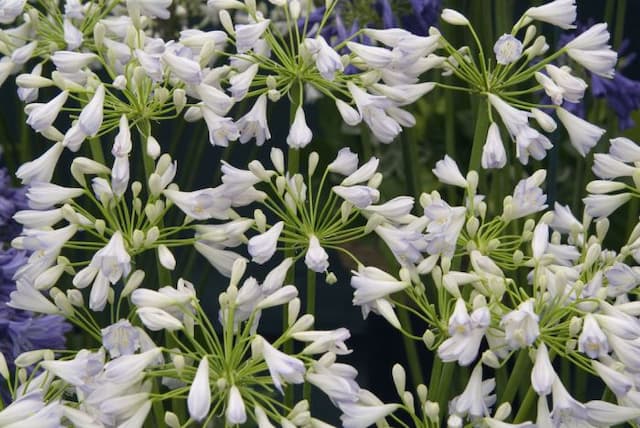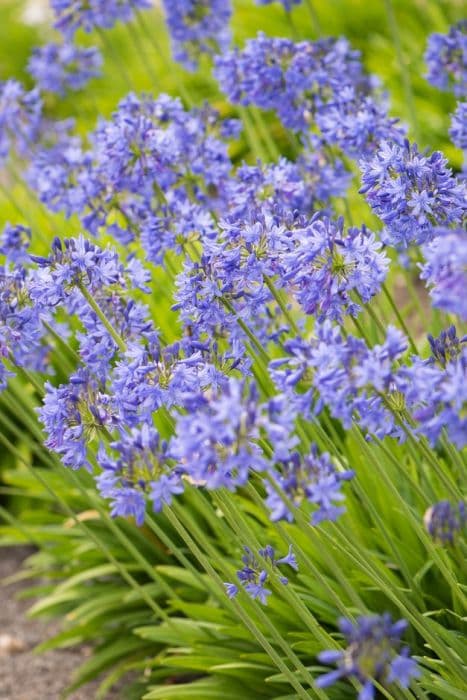Lily of the Nile Agapanthus praecox 'Albiflorus'

ABOUT
Agapanthus praecox 'Albiflorus', commonly known as the white lily of the Nile, is an ornamental plant known for its striking appearance. It has long, glossy, strap-shaped leaves that arch gracefully and create a lush, fountain-like foliage at the base. The leaves are dark green and provide a contrasting backdrop to the plant's standout feature: its blooms. The white lily of the Nile produces impressive globes of trumpet-shaped white flowers that are arranged in large, rounded clusters atop tall, sturdy stalks that emerge from the foliage. These flower clusters, often referred to as umbels, look like spheres of blooms sitting on a pedestal of green. The individual flowers within these clusters are pristine white, and their delicate appearance adds an ethereal quality to the plant. The contrast between the dark green leaves and the pure white flowers creates a visually appealing display, making it a popular choice for gardeners looking to add a touch of elegance to their landscapes. The blossoms of the white lily of the Nile also attract a variety of pollinators, adding to the dynamism of the garden. The overall look of the Agapanthus praecox 'Albiflorus' is one of structured beauty, blending both architectural form and natural charm.
About this plant
 Names
NamesFamily
Amaryllidaceae.
Synonyms
African Lily, Blue African Lily, Lily of the Nile.
Common names
Agapanthus africanus, Agapanthus orientalis, Agapanthus umbellatus, Agapanthus campanulatus, Agapanthus breviflorus, Agapanthus intermedius, Agapanthus minor, Agapanthus parviflorus, Agapanthus subbiflorus, Agapanthus tuberosus, Agapanthus umbellatus var. maximus, Agapanthus villosus, Tulbaghia africana.
 Toxicity
ToxicityTo humans
The common name for Agapanthus praecox 'Albiflorus' is Lily of the Nile. This plant is considered to be mildly toxic to humans if ingested. The toxic components are found throughout the plant, but the highest concentration is typically in the sap and roots. Symptoms of ingestion can include nausea, vomiting, abdominal pain, and diarrhea. In severe cases, it can result in dizziness or cardiac arrhythmia, although such extreme reactions are rare. It is important to handle the plant with care and to ensure that children do not ingest any parts of the plant.
To pets
The common name for Agapanthus praecox 'Albiflorus' is Lily of the Nile. This plant is known to be toxic to pets, especially cats and dogs. The toxic principles in the plant can cause gastrointestinal irritation, which may result in symptoms such as vomiting, diarrhea, and in some cases, excessive salivation. If large quantities of the plant are consumed, it can potentially lead to more serious effects, such as tremors or cardiac issues. Pet owners should keep this plant out of reach and monitor their pets when they are around plants like the Lily of the Nile. If a pet exhibits symptoms after ingesting the plant, contacting a veterinarian promptly is advisable.
 Characteristics
CharacteristicsLife cycle
Perennials
Foliage type
Evergreen
Color of leaves
Green
Flower color
White
Height
3 feet (0.9 meters)
Spread
2 feet (0.6 meters)
Plant type
Herb
Hardiness zones
9
Native area
South Africa
Benefits
 General Benefits
General Benefits- Ornamental Value: 'Albiflorus' is known for its beautiful white flowers that add aesthetic appeal to gardens and landscapes.
- Drought Tolerance: Once established, this variety of African Lily is quite drought-resistant, requiring minimal watering.
- Low Maintenance: It requires minimal care once established, making it suitable for gardeners of all skill levels.
- Attracts Pollinators: The flowers attract bees and butterflies, which are beneficial for the pollination of other garden plants.
- Tolerant to a Range of Soils: It can thrive in a variety of soil conditions, although it prefers well-drained soil.
- Long Blooming Period: This plant has a lengthy blooming season, which can last from spring to summer, providing extended visual interest.
- Perennial Growth: As a perennial, it will return year after year, reducing the need to replant annually.
- Borders and Beds: Suitable for planting in borders and flower beds where it can provide structure and height.
- Container Gardening: It can be grown in pots and containers, making it versatile for those with limited garden space.
- Deer Resistance: Generally resistant to deer, which makes it a good choice for gardens in areas with deer populations.
- Erosion Control: The root system of the African Lily helps to stabilize soil and prevent erosion on slopes or in areas with loose soil.
 Medical Properties
Medical Properties- This plant is not used for medical purposes.
 Air-purifying Qualities
Air-purifying QualitiesThis plant is not specifically known for air purifying qualities.
 Other Uses
Other Uses- Agapanthus can be used as a natural dye source. The blue and purple flowers of the Agapanthus can be used to extract natural dyes for coloring fabrics and textiles.
- They are often used in stormwater management systems. Agapanthus plants have robust root systems that can help stabilize soil and reduce erosion in rain gardens and bioswales.
- Agapanthus is suitable for use in floristry. Their long-lasting cut flowers are popular for floral arrangements and bridal bouquets.
- Their leaves can be used in basket weaving. The fibrous leaves of Agapanthus can be dried and woven into baskets and other craft items.
- Agapanthus serves as an attractive edging plant. They can be used to define borders along walkways or garden beds due to their neat, clumping growth habit.
- They can be used as a privacy screen. When planted in mass, their dense foliage can create a living screen, offering a degree of privacy in the garden.
- Agapanthus plants can be used in xeriscaping. They are drought-tolerant once established, making them suitable for water-wise gardens.
- They provide nectar for pollinators. Agapanthus flowers attract bees, butterflies, and hummingbirds, supporting local biodiversity.
- Their seed pods are used in dry flower arrangements. After the flowers fade, the decorative seed pods can add interest to dried floral displays.
- Agapanthus can be a focal point in pot arrangements. Due to their striking flowers, they work well as the centerpiece in mixed container plantings.
Interesting Facts
 Feng Shui
Feng ShuiThe Lily of the Nile is not used in Feng Shui practice.
 Zodiac Sign Compitability
Zodiac Sign CompitabilityThe Lily of the Nile is not used in astrology practice.
 Plant Symbolism
Plant Symbolism- Love Letters: The genus name Agapanthus is derived from the Greek words 'agape' meaning love, and 'anthos' meaning flower, symbolizing love letters or messages.
- Beauty: Agapanthus, commonly known as African Lily, often symbolizes beauty due to its striking blue or white blooms that command attention in any garden or arrangement.
- Fertility: African Lily's lush and prolific flowering can represent fertility or blossoming of new ideas and ventures.
- Eloquence: The elegant form of the African Lily suggests eloquence and a graceful articulation of thoughts and feelings.
 Water
WaterFor the Lily of the Nile, which is the common name for Agapanthus praecox 'Albiflorus', the watering schedule should be consistent, ensuring the soil is kept moist but never soggy. During the growing season, from spring through fall, water the plant once every week with about 1 gallon of water per square yard of soil. In winter, reduce watering to every other week or when the soil feels dry to the touch. It's important to water deeply to encourage root growth, allowing the water to reach the root zone. Avoid overhead watering to minimize the risk of leaf spot diseases.
 Light
LightLily of the Nile thrives in full sun but can tolerate partial shade. The best spot for this plant is an area that receives at least 6 hours of direct sunlight per day, though afternoon shade is beneficial in extremely hot climates. Avoid deep shade locations, where the plant will produce fewer blooms and may become leggy.
 Temperature
TemperatureThe Lily of the Nile prefers a temperate climate and can handle temperatures as low as 50°F without damage. Ideally, this plant should be grown in areas where temperatures range between 60°F to 75°F for optimal growth. It can survive brief periods of colder frost but sustained temperatures below 50°F may damage the foliage and roots.
 Pruning
PruningPruning the Lily of the Nile is mainly done to remove spent flower stalks and to tidy up the plant. Prune away dead or faded blooms and stalks at the base in late fall or early winter after flowering has ceased. This encourages new growth and helps maintain an attractive appearance. The best time for a thorough pruning is in early spring as new growth begins.
 Cleaning
CleaningAs needed
 Soil
SoilThe best soil mix for Lily of the Nile (Agapanthus praecox 'Albiflorus') is a well-draining soil with plenty of organic matter, such as a mix of loam, sand, and compost or aged manure. The ideal soil pH for this plant is slightly acidic to neutral, ranging from 6.0 to 7.0.
 Repotting
RepottingLily of the Nile should be repotted every 2 to 3 years or when the root system has outgrown its current container. This helps to refresh the soil and give roots more space to grow.
 Humidity & Misting
Humidity & MistingLily of the Nile prefers moderate humidity levels but is quite adaptable and can tolerate the drier conditions typically found in home environments.
 Suitable locations
Suitable locationsIndoor
Place in bright, indirect light; water when topsoil is dry.
Outdoor
Plant in full sun to partial shade; ensure good drainage.
Hardiness zone
8-11 USDA
 Life cycle
Life cycleThe Agapanthus praecox 'Albiflorus', commonly known as the White African Lily or White Agapanthus, begins its life as a seed, which germinates in the spring under the right conditions of moisture and temperature. The seedling develops into a young plant with strap-shaped leaves and builds a fleshy root system. As the plant matures, it forms an evergreen clump with lush foliage from which flower stalks emerge, typically in the summer, displaying rounded clusters of trumpet-shaped white flowers. After flowering, seed pods develop and eventually split open to release seeds, completing the reproductive cycle. Throughout the year, the White Agapanthus continues to grow vegetatively, with the rhizomes beneath the soil surface dividing and leading to the expansion of the plant colony. It can also propagate asexually when clumps are divided by gardeners, which contributes to its spread and longevity in cultivated settings.
 Propogation
PropogationPropogation time
Spring to Summer
Propogation: The most popular method of propagating the Agapanthus praecox 'Albiflorus', commonly known as Lily of the Nile, is through division of its clump-forming rhizomes. Typically, the best time to propagate Lily of the Nile by division is in late summer to early fall, after the blooming period has ended and the plant is entering a period of rest. To propagate through division, carefully dig up an established clump and gently separate it into smaller sections, each with a portion of the root system and several growing points. These sections should then be immediately replanted in well-draining soil, at the same depth they were previously growing. Water the newly planted divisions thoroughly to help establish them. It is important to give each division enough space to accommodate future growth, ideally about 18 inches (approximately 45 centimeters) apart.









